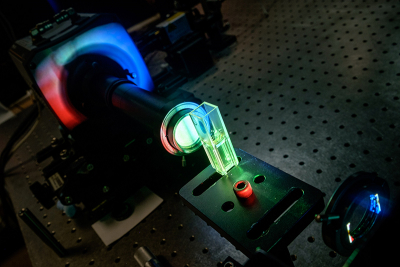
A new camera technology developed by scientists from Nanyang Technological University, Singapore (NTU Singapore) can take sharp, colour images without using a lens and colour filters. Using only a piece of ground glass and a monochrome sensor, the scientists created multi-coloured images by “reverse engineering” the light that is scattered by the translucent matt surface of the ground glass, thus obtaining the original image that was projected on to it.
Since different wavelengths of light are scattered differently by the ground glass, the NTU scientists created an algorithm to reconstruct the image. To do this they created a library of “speckle patterns” linked to each wavelength of light, including those in the infrared and ultraviolet spectral regions. In a conventional camera, optics made from glass or plastic lenses capture light and guide it onto the colour filters and camera sensor to obtain sharp colour images. These lenses are usually bulky in size and expensive due to the precision manufacturing required. By removing the need for a lens and colour filters and replacing them with ground glass, this innovation could potentially be used in compact cameras and smart phones to make them slimmer.
Assistant Professor Steve Cuong Dang from the NTU School of Electrical and Electronic Engineering, who led the research, said their new imaging technique could help to improve imaging applications in biomedical and scientific applications as well as opening new doors for other industries.
“Our technology can also reconstruct images in other multiple wavelengths invisible to the naked eye, like infrared and ultraviolet, which are used in imaging purposes for medicine, surveillance and astrophysics. It can also reconstruct images taken at the microscopic scale,” explained Professor Dang. “Our multispectral imaging technique uses a monochromic (black and white) camera coupled with a simple piece of ground glass, making it very cost-effective compared to existing multispectral cameras on the market. The unique feature of our camera is that it can capture any range of light spectrum, unlike existing cameras on the market which are pre-fixed. It is also less affected by optical alignment issues like conventional cameras, because there are no moving parts and no focusing optics.”
With only a snapshot picture and a computational algorithm, this multispectral imaging technique combines the strengths of vision technology and spectroscopy to do multiple analysis at very high speeds. A patent has been filed for this new technology by NTU’s innovation and enterprise arm, NTUitive, and the research team will be engaging industry partners to see how they can adapt their technology for real-world applications.
Details of the research was published in Optica in October 2017.










